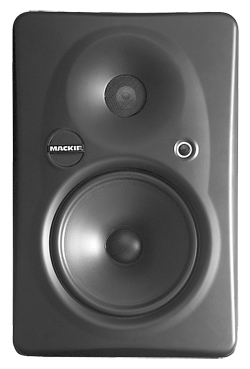 MARK 2 IN USE
MARK 2 IN USE
I have always liked the original Mackie 824s, and I have to say I expected that the Mk2 versions wouldn’t measure up. Despite the change in drivers and the switch to titanium for the tweeter dome material, the new HR824 Mk2 manages to keep essentially the same family sound as its predecessor, and though some of the high frequency detail sounds a bit less clear than before, the overall sound is still smooth and well-balanced, and it doesn’t start to sound brash unless the mix itself is over-aggressive. So if you like the original Mackie monitors, you’ll have no trouble with these.
The HR624 Mk2s incarnation actually sound pretty similar to the originals, like the HR824 Mk2, they are a little smoother at the high end. I’d say the upper-mid range was probably a bit cleaner, and the really high end a bit more pronounced, which results in a sound that is both smoother and more detailed at the same time. The maximum SPL is 5dB below that for the HR824 Mk2 and the frequency response drops off around 48Hz, but other than that the character is uncannily similar. Subjectively (once you have balanced their levels) only the depth of the bass extension of the HR824 Mk2 really sets it apart from its smaller sibling.
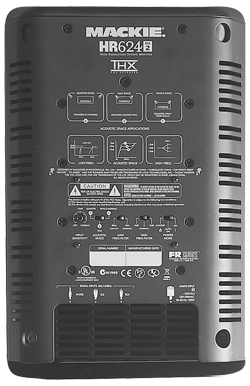 But, as I’ve mentioned, it isn’t a simple repackaging. On well-mixed material the overall sound is a touch smoother and seems less ‘in-your-face’. The mid-range retains clarity and detail at least as well as before — and possibly a little better — while the smooth, deep bass always impresses, particularly for speakers of this size. The fact that the passive radiator is at the rear means that mounting too close to walls is never a great idea, and because the bass extension is so impressive, corner-mounting is definitely to be avoided.
But, as I’ve mentioned, it isn’t a simple repackaging. On well-mixed material the overall sound is a touch smoother and seems less ‘in-your-face’. The mid-range retains clarity and detail at least as well as before — and possibly a little better — while the smooth, deep bass always impresses, particularly for speakers of this size. The fact that the passive radiator is at the rear means that mounting too close to walls is never a great idea, and because the bass extension is so impressive, corner-mounting is definitely to be avoided.
Problems can also arise in rooms that are not acoustically suitable for the reproduction of very low frequencies, though you can use the LF switch to select the middle setting. In a typical project-studio room, that can work really well, and there’s still plenty of low end. But overall these new versions are remarkably similar to the previous ones I like so very much.
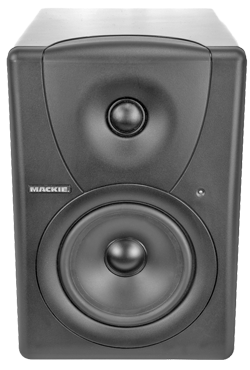 THE CONTENDERS MR5 AND MR8
THE CONTENDERS MR5 AND MR8
Mackie’s new MR5 monitors are less costly counterparts of the HR624 Mk2s, and the larger MR8s are similarly comparable with the HR824 Mk2s. Both MR models are aimed at smaller rooms where budgets are tighter but accurate monitoring is still essential.
As with the MR8s, the two-way, active MR5s have a built-in tweeter waveguide to control dispersion, as well as the usual array of acoustic controls on the rear panel — so you can tailor the response to suit your room and the location of the speakers within it. All the baffle elements surrounding the drivers are smooth to minimize diffraction, and the drivers themselves are powered by Class-A/B MOSFET amplifiers. These amps include active protection circuits and deliver 55W into the woofer and 30W into the tweeter. A 24dB/oct crossover operates at 4kHz, and an overall frequency response of 60Hz to 20kHz (+/-3dB) is quoted. There’s also more than enough level (113dB peak per pair at one meter) for a nearfield environment.
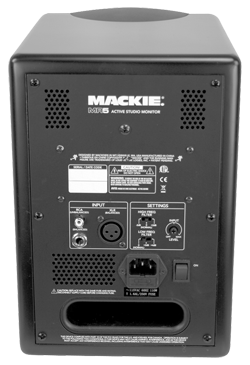 The rear panel offers both balanced and unbalanced inputs and is also home to the rear port (there is no radiator as on the HR-series). Tucking the port around the back at least means it won’t part your hair, although it also means you can’t push the monitors right up against a wall. Balanced XLR, TRS and unbalanced RCA inputs are available, along with a knob for level control. AC power is via an IEC socket, next to which is the power switch. When the monitors are powered up, an unobtrusive white LED lights on the baffle.
The rear panel offers both balanced and unbalanced inputs and is also home to the rear port (there is no radiator as on the HR-series). Tucking the port around the back at least means it won’t part your hair, although it also means you can’t push the monitors right up against a wall. Balanced XLR, TRS and unbalanced RCA inputs are available, along with a knob for level control. AC power is via an IEC socket, next to which is the power switch. When the monitors are powered up, an unobtrusive white LED lights on the baffle.
MDF is used for the MR-series enclosures for its dense, uniform structure, with internal bracing and open-cell foam filling the internal air space to absorb reflections. All the corners are nicely rounded and the cabinet sides are finished in a black satin paint. The MR5’s drivers consist of a 5-1/4" steel-frame woofer, teamed with a one-inch, silk-domed tweeter, mounted behind a shallow waveguide.
As expected, the MR8 has a larger cabinet that is almost twice the size of the MR5. The low end is handled by an 8" steel frame driver, and the amplifier power is 100W for the woofer and 50W for the tweeter, but otherwise the construction and feature set is very similar to the MR5. The frequency range extends from 40Hz to 20kHz (+/-3dB) and there’s 3dB more level to play with. A slightly different design is used for the tweeter amplifier, while the low end benefits from a more traditional discrete design that is based around bipolar transistors. An electronic crossover with a 24dB/oct slope splits the incoming audio at 3kHz.
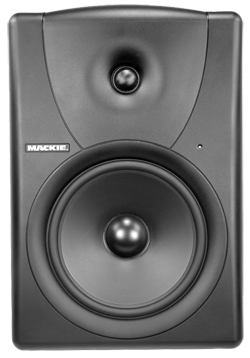 MR SERIES IN USE
MR SERIES IN USE
The MR speakers certainly look the part but at around half the price of the Mackie monitors we’ve come to know and love, what’s missing? Where are the compromises? Actually, there aren’t too many. The sound of the little MR5 is punchy, with a smooth mid-range and no harshness at the top. However, in my room with the speakers a couple of feet from the wall, the low end seemed hyped on the flat setting. Moving the tweeter up to its +2dB setting helps fix the balance but my sense is that the low end has been tuned to sound “PHAT” and the result is that the balance isn’t what it should be. There’s just too much bottom here, and I could definitely use a -2dB setting for the bass. Nevertheless, I’m impressed with the overall sound, especially at that price point. These speakers delivered detail without getting noticeably harsh or gritty at the top end. The stereo imaging is decent (as you’d expect from a small speaker), and the phantom central image is reasonably solid too.
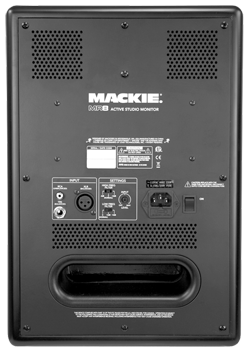 You might think that the larger MR8s — with their greater bass extension — would kill you will thump, but that actually turned out not to be the case. They reproduce the low end without effort, and there’s definitely less hype of the 80 Hz - 90 Hz region than with the MR5s. Although they’re half the price of a pair of HR824s, they’re not far off in terms of performance. The original 824s have more air on the top end, more overall clarity and better stereo imaging, but the overall character is quite similar.
You might think that the larger MR8s — with their greater bass extension — would kill you will thump, but that actually turned out not to be the case. They reproduce the low end without effort, and there’s definitely less hype of the 80 Hz - 90 Hz region than with the MR5s. Although they’re half the price of a pair of HR824s, they’re not far off in terms of performance. The original 824s have more air on the top end, more overall clarity and better stereo imaging, but the overall character is quite similar.
WRAP IT
If you like Mackie monitors, then you’ll like the HR824 and HR624 Mark 2 versions. No, they’re not identical, but I doubt there are many who will object to the subtle differences. They’re priced about the same as the originals, so they’re not cheap, but they are worth it unless you just don’t like Mackie monitors.
The newer MR series is a mixed bag. If your budget will tolerate the MR8, then they bear consideration as one of the better choices for that money. The MR5s are a bargain price-wise, but to my ear the excess low end punch was a serious distraction and a problem for me. I much preferred the more-expensive MR8.
The Mackie HR824 Mk2 studio monitors carry a suggested retail price of $779.99 each, and a pair of them will street out at about $1300 (USD). That’s about the same street price as the Mk1’s carried back in the day. The HR624 Mk2’s list at $589.99 each with a street of around $900 per pair. Neither are cheap, but the prices remain about the same as for the earlier well-loved versions.
The Mackie MR8 studio monitors carry a retail price of $329.99 each, which means a pair should street under $500 (USD). The MR5’s retail for $199.99, so a pair on the street should be around $300. No, they’re not quite the same, but they’re above average, that’s for certain. For more information worldwide, visit www.mackie.com.

